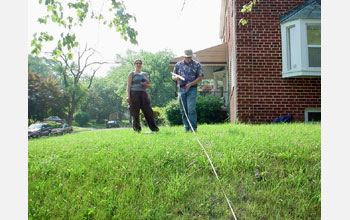Multimedia Gallery
Baltimore Ecosystem Study (Image 1)
Baltimore Ecosystem Study (Image 1)
Two technicians working with the Baltimore Ecosystem Study (BES) collect data at an Urban Forest Effects Model (UFORE) plot in Baltimore, Md. BES scientists collect data across a range of land uses that occur in the city of Baltimore, including residential neighborhoods. There are 200 UFORE plots in the city that provide long-term data on tree, shrub and herbaceous vegetation strata.
BES is a long-term ecological research (LTER) project funded by the National Science Foundation (grant 98-41771) and the Environmental Protection Agency. The purpose of the program is to learn how an urban area works as an ecological system. Specifically, scientists want to know the ecological interactions in the whole range of habitats, from the center city of Baltimore, out into the surrounding rural areas. BES participants are conducting research on the soil, plants and animals on land and in streams, the water quality, and the condition of the air in and around Baltimore. For this information to make sense, scientists must also study how families, associations, organizations and political bodies make decisions that affect ecological processes. In other words, BES is treating the whole collection of urban, suburban and rural areas as an ecological system that includes people and their activities. (Date of Image: June 2004) [See Related Image.]
Credit: Charles Nilon, Baltimore Ecosystem Study Long Term Ecological Research Project and University of Missouri-Columbia
Images and other media in the National Science Foundation Multimedia Gallery are available for use in print and electronic material by NSF employees, members of the media, university staff, teachers and the general public. All media in the gallery are intended for personal, educational and nonprofit/non-commercial use only.
Images credited to the National Science Foundation, a federal agency, are in the public domain. The images were created by employees of the United States Government as part of their official duties or prepared by contractors as "works for hire" for NSF. You may freely use NSF-credited images and, at your discretion, credit NSF with a "Courtesy: National Science Foundation" notation.
Additional information about general usage can be found in Conditions.
Also Available:
Download the high-resolution JPG version of the image. (814 KB)
Use your mouse to right-click (Mac users may need to Ctrl-click) the link above and choose the option that will save the file or target to your computer.

